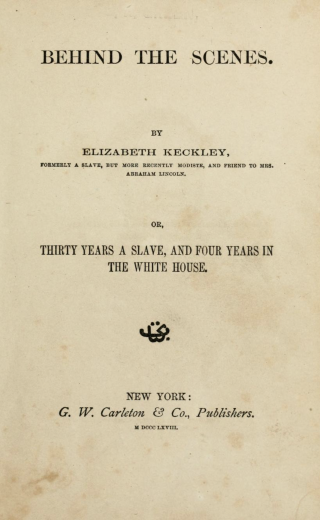While archivists are in the midst of discussing slavery in our collections, we are often in the meta-process of describing people’s descriptions of their own enslavement. The language choices those men and women made when publishing their narratives were exponentially more fraught and considered than those we make describing them, but as with most writing, audience perception and reception played a key role.
Elizabeth Keckley’s memoir, Behind the Scenes, or, Thirty Years a Slave and Four in the White House was one of the latest additions to the literary genre known as the slave narrative. Beginning with the 1770 autobiography A Narrative of the Most Remarkable Particulars in the Life of James Albert Ukawsaw Gronniosaw, an African Prince, the genre grew into a recognized form, with standardized structural elements that have been described in detail by scholars like James Olney. These narratives were written with social and political goals in mind, using stories of oppression and eventual fugitivity or emancipation to convince primarily white readers of the need for abolition and to support the civil rights of Black people.
Behind the Scenes was published in 1868, and presents a unique view into a Black woman’s independence and self-assertion. By the time of publication, Keckley had become a well-known clothier, training other Black women as seamstresses and even serving, as the book’s title alludes, as Mary Todd Lincoln’s personal stylist for four years. Keckley’s expertise as a modiste is documented in photographs and even in surviving clothing items themselves, like those held at the Smithsonian National Museum of African American History and Culture, as well as in the story of her own life.
Keckley was born into slavery in 1818 Virginia. She began sewing at an early age and throughout her enslaved life, which lasted decades and included all manner of abuse, made connections for herself and money for her enslavers through her craft. In the late 1847s, her family was moved to St. Louis. She was now mother to a young son, the product of sexual assault. Committed to providing freedom for herself and her son, she refused to marry her suitor, James St. Louis, until she had purchased their manumission. Using community connections she’d built both with the large free Black community and White patrons, Keckley raised loans of the required 1,200 dollars (the equivalent to almost 44,000 in 2022). Once freed she worked creating garments in Missouri for five or so years to repay the loans and start her life free of debt and slavery.
